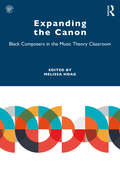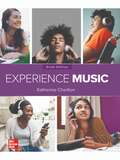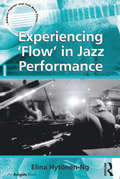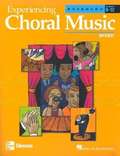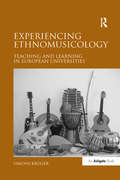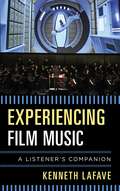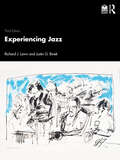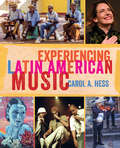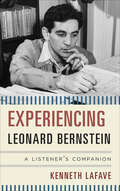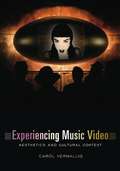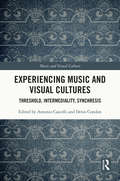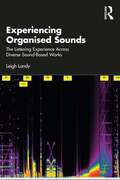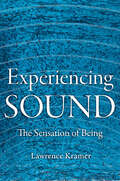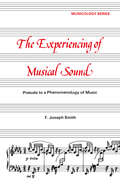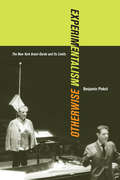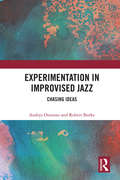- Table View
- List View
Expanding the Canon: Black Composers in the Music Theory Classroom
by Melissa HoagDirectly addressing the underrepresentation of Black composers in core music curricula, Expanding the Canon: Black Composers in the Music Theory Classroom aims to both demonstrate why diversification is badly needed and help faculty expand their teaching with practical, classroom-oriented lesson plans that focus on teaching music theory with music by Black composers. This collection of 21 chapters is loosely arranged to resemble a typical music theory curriculum, with topics progressing from basic to advanced and moving from fundamentals, diatonic harmony, and chromatic harmony to form, popular music, and music of the twentieth and twenty-first centuries. Some chapters focus on segments of the traditional music theory sequence, while others consider a single style or composer. Contributors address both methods to incorporate the music of Black composers into familiar topics, and ways to rethink and expand the purview of the music theory curriculum. A foreword by Philip Ewell and an introductory narrative by Teresa L. Reed describing her experiences as an African American student of music set the volume in wider context. Incorporating a wide range of examples by composers across classical, jazz, and popular genres, this book helps bring the rich and varied body of music by Black composers into the core of music theory pedagogy and offers a vital resource for all faculty teaching music theory and analysis.
Expanding the Horizon of Electroacoustic Music Analysis
by Leigh Landy Simon Emmerson Emmerson, Simon and Landy, LeighInnovations in music technology bring with them a new set of challenges for describing and understanding the electroacoustic repertoire. This edited collection presents a state-of-the-art overview of analysis methods for electroacoustic music in this rapidly developing field. The first part of the book explains the needs of differing electroacoustic genres and puts forward a template for the analysis of electroacoustic music. Part II discusses the latest ideas in the field and the challenges associated with new technologies, while Part III explores how analyses have harnessed the new forces of multimedia, and includes an introduction to new software programme EAnalysis, which was created by the editors as the result of an Arts and Humanities Research Council grant. The final part of the book demonstrates these new methods in action, with analyses of key electroacoustic works from a wide range of genres and sources.
Expanding the Music Theory Canon: Inclusive Examples for Analysis from the Common Practice Period
by Paula MaustFeaturing music by sixty-seven historical women and/or people of color, Expanding the Music Theory Canon is designed to supplement any introductory Western classical music theory curriculum. At a time when many academics are focused on increasing diversity and inclusion, this book provides the means to seamlessly incorporate works by underrepresented composers into music theory core courses. The anthology’s 255 musical examples are organized topically and include excerpts as well as nineteen complete pieces for analysis. Each chapter begins with guided analysis questions aimed at students approaching these concepts for the first time. Notably, this anthology provides a biography and image for each composer, which is particularly significant since works by these individuals have rarely been included in previous textbooks or anthologies. A related website, www.expandingthemusictheorycanon.com, provides additional examples and links to recordings when available. All musical examples in the anthology have been classroom-tested with music majors and minors at a major conservatory, at private and public universities, and at community colleges. Detailed tables provide suggestions for using this book in conjunction with the major introductory theory textbooks. A special set of online exercises has been prepared by the book's author using the Auralia & Musition software programs; you can find further information here: https://www.risingsoftware.com/expanding-the-music-theory-canon. Additional examples and a blog offering teaching suggestions may be found at: https://www.expandingthemusictheorycanon.com.
Experience Music
by Katherine CharltonExperience Music offers a listening experience—first hearing featured listening and finale—along with Spotify playlists and interactive listening guides to motivate and engage students. With McGraw Hill’s Connect® students can come to class confident and prepared as they develop the active listening skills they need for success in the course and a lifetime of more meaningful musical experiences.McGraw Hill’s Connect® offers a learning environment for students to actively engage in listening to music and build their vocabulary in this course area. Students connect to music through interactive assignments such as listening experience activities and hearing the difference comparison questions. Students can access and stream music through the interactive listening guides or through embedded audio players in eBooks.Instructors can assess the development of students’ listening skills—online and at any time—so that they don’t have to wait for a midterm for an update on their progress.
Experiencing 'Flow' in Jazz Performance (Ashgate Popular and Folk Music Series)
by Elina Hytonen-NgThe term 'flow' refers to experiences where the musician moves into a consciousness in which time seems to be suspended and perception of reality is blurred by unconscious forces. An essential part of the jazz tradition, which often serves as the foundation of the musician's identity, flow is recognised within the greater jazz community as a critical factor in accomplished musicianship. Flow as a concept is so deeply embedded in the scene that these experiences are not generally discussed. It contributes to the musicians' work motivation, providing a vital level of satisfaction and accomplishment. The power of the experience, consciously or unconsciously, has given rise to the creation of heroic images, in which jazz musicians are seen as being bold, yet vulnerable, strong and masculine, but still capable of expressing emotions. In this discourse, musicians are pictured as people constantly putting themselves on the line, exposing themselves and their hearts to one another as well as to the audience. Heroic profiles are richly constructed within the jazz scene, and their incorporation into narratives of flow suggests that such images are inseparable from jazz. It is thus unclear how far the musicians are simply reporting personal experience as opposed to unconsciously perpetuating a profoundly internalised mythology. Drawing on eighteen interviews conducted with professional jazz musicians from around the world, Elina Hytönen-Ng examines the fundamentals of the phenomenon of flow in jazz that has led to this genre's popularity. Furthermore, she draws on how flow experiences are viewed and constructed by jazz musicians, the meanings they attach to it, and the quality of music that it inspires.
Experiencing Choral Music: Advanced Mixed Voices
by Hal Leonard CorporationExperiencing Choral Music is a four-level series designed to build music literacy and promote vocal development for all students and voice categories in grades 6 - 12. The series is a multi-textbook program supported with print materials and audio recordings that enables students to develop music skills and conceptual understanding, while providing teachers with a flexible, integrated program. Available in 4 levels: Beginning, Intermediate, Proficient, and Advanced. Written for Treble, Mixed, or Tenor/Bass voices. Twenty-four graded choral selections per book covering a variety of styles, cultures, and historical periods. Every song is recorded in 3 ways: voices and accompaniment, accompaniment only, and part dominant CDs. Each of the 4 levels is accompanied by a Sight-Singing book.
Experiencing Ethnomusicology: Teaching and Learning in European Universities
by Simone Kr�gerSimone Kr�ger provides an innovative account of the transmission of ethnomusicology in European universities, and explores the ways in which students experience and make sense of their musical and extra-musical encounters. By asking questions as to what students learn about and through world musics (musically, personally, culturally), Kr�ger argues that musical transmission, as a reflector of social and cultural meaning, can impact on students' transformations in attitude and perspectives towards self and other. In doing so, the book advances current discourse on the politics of musical representation in university education as well as on ethnomusicology learning and teaching, and proposes a model for ethnomusicology pedagogy that promotes in students a globally, contemporary and democratically informed sense of all musics.
Experiencing Film Music: A Listener's Companion
by Kenneth LaFaveOf all the elements that combine to make movies, music sometimes seems the forgotten stepchild. Yet it is an integral part of the cinematic experience. Minimized as mere "background music," film scores enrich visuals with emotional mood and intensity, underscoring directors' intentions, enhancing audiences' reactions, driving the narrative forward, and sometimes even subverting all three. Trying to imagine The Godfather or Lawrence of Arabia with a different score is as difficult as imagining them featuring a different cast. In Experiencing Film Music: A Listener's Companion, Kenneth LaFave guides the reader through the history, ideas, personalities, and visions that have shaped the music we hear on the big screen. Looking back to the music improvised for early silent movies, LaFave traces the development of the film score from such early epic masterpieces as Max Steiner's work for Gone With the Wind, Bernard Herrmann's musical creations for Alfred Hitchcock's thrillers, Jerry Goldsmith's sonic presentation of Chinatown, and Ennio Morricone's distinctive rewrite of the Western genre, to John Williams' epoch-making Jaws and Star Wars. LaFave also brings readers into the present with looks at the work over the last decade and a half of Hans Zimmer, Alan Silvestre, Carter Brey, and Danny Elfman. Experiencing Film Music: A Listener's Companion opens the ears of film-goers to the nuance behind movie music, laying out in simple, non-technical language how composers and directors map what we hear to what we see--and, not uncommonly, back again.
Experiencing Jazz
by Richard J. Lawn Justin G. BinekExperiencing Jazz, Third Edition is an integrated textbook, website, and audio anthology for jazz appreciation and history courses. Through readings, illustrations, timelines, listening guides, and a playlist of tracks and performances, Experiencing Jazz journeys through the history of jazz and places the music within larger cultural and historical contexts. Designed for the jazz novice, this textbook introduces the reader to prominent artists, covers the evolution of styles, and makes stylistic comparisons to current trends and developments. New to the third edition: Richard J. Lawn is joined by new co-author Justin G. Binek Expanded coverage of artists, particularly important vocalists and prominent women in jazz, including Bobby McFerrin, Kurt Elling, The Manhattan Transfer, and Terri Lyne Carrington A dynamic, web-exclusive bonus chapter—Chapter 14.5: The Story Continues—exploring contemporary jazz artists who push the boundaries of jazz by creating new stylistic fusions and who utilize new media to create, collaborate, and share their artistry A re-worked companion website featuring new recordings, a more comprehensive audio anthology, and a major revision of The Elements of Jazz section Condensed musician biographies and updated content reflecting jazz’s global impact Revised listening guides for spotlighted recordings highlighting key moments worthy of closer listening and analysis Comprehensive and immersive, the third edition of Experiencing Jazz provides a foundational understanding of the history of the genre.
Experiencing Jazz
by Richard J. Lawn Justin G. BinekExperiencing Jazz, Third Edition is an integrated textbook, website, and audio anthology for jazz appreciation and history courses. Through readings, illustrations, timelines, listening guides, and a playlist of tracks and performances, Experiencing Jazz journeys through the history of jazz and places the music within larger cultural and historical contexts. Designed for the jazz novice, this textbook introduces the reader to prominent artists, covers the evolution of styles, and makes stylistic comparisons to current trends and developments.New to the third edition: Richard J. Lawn is joined by new co-author Justin G. Binek Expanded coverage of artists, particularly important vocalists and prominent women in jazz, including Bobby McFerrin, Kurt Elling, The Manhattan Transfer, and Terri Lyne Carrington A dynamic, web-exclusive bonus chapter—Chapter 14.5: The Story Continues—exploring contemporary jazz artists who push the boundaries of jazz by creating new stylistic fusions and who utilize new media to create, collaborate, and share their artistry A re-worked companion website featuring new recordings, a more comprehensive audio anthology, and a major revision of The Elements of Jazz section Condensed musician biographies and updated content reflecting jazz’s global impact Revised listening guides for spotlighted recordings highlighting key moments worthy of closer listening and analysis Comprehensive and immersive, the third edition of Experiencing Jazz provides a foundational understanding of the history of the genre.
Experiencing Jazz: eBook Only
by Richard J. LawnExperiencing Jazz, Second Edition, is an integrated textbook with online resources for jazz appreciation and history courses. Through readings, illustrations, timelines, listening guides, and a streaming audio library, it immerses the reader in a journey through the history of jazz, while placing the music within a larger cultural and historical context. Designed to introduce the novice to jazz, Experiencing Jazz describes the elements of music, and the characteristics and roles of different instruments. Prominent artists and styles from the roots of jazz to present day are relayed in a story-telling prose. This new edition features expanded coverage of women in jazz, the rise of jazz as a world music, the influence of Afro-Cuban and Latin jazz, and streaming audio. Features: Important musical trends are placed within a broad cultural, social, political, and economic context Music fundamentals are treated as integral to the understanding of jazz, and concepts are explained easily with graphic representations and audio examples Comprehensive treatment chronicles the roots of jazz in African music to present day Commonly overlooked styles, such as orchestral jazz, Cubop, and third-stream jazz are included Expanded and up-to-date coverage of women in jazz The media-rich companion website presents a comprehensive streaming audio library of key jazz recordings by leading artists integrated with interactive listening guides. Illustrated musical concepts with web-based tutorials and audio interviews of prominent musicians acquaint new listeners to the sounds, styles, and figures of jazz. Course components The complete course comprises the textbook and Online Access to Music token, which are available to purchase separately. The textbook and Online Access to Music Token can also be purchased together in the Experiencing Jazz Book and Online Access to Music Pack. Book and Online Access to Music Pack: 978-0-415-65935-2 (Paperback and Online Access to Music) Book Only: 978-0-415-69960-0 (please note this does not include the Online Access to Music) Online Access to Music Token: 978-0-415-83735-4 (please note this does not include the textbook) eBook and Online Access to Music Pack: 978-0-203-37981-3 (available from the Taylor & Francis eBookstore) ebook: 978-0-203-37985-1 (please note this does not include the audio and is available from the Taylor & Francis eBookstore)
Experiencing Latin American Music
by Carol A. HessExperiencing Latin American Music draws on human experience as a point of departure for musical understanding. Students explore broad topics—identity, the body, religion, and more—and relate these to Latin American musics while refining their understanding of musical concepts and cultural-historical contexts. With its brisk and engaging writing, this volume covers nearly fifty genres and provides both students and instructors with online access to audio tracks and listening guides. A detailed instructor’s packet contains sample quizzes, clicker questions, and creative, classroom-tested assignments designed to encourage critical thinking and spark the imagination. Remarkably flexible, this innovative textbook empowers students from a variety of disciplines to study a subject that is increasingly relevant in today’s diverse society. In addition to the instructor’s packet, online resources for students include:customized Spotify playlistonline listening guidesaudio sound links to reinforce musical conceptsstimulating activities for individual and group work
Experiencing Leonard Bernstein: A Listener's Companion
by Kenneth LaFaveLeonard Bernstein is a household name. Most know him for his classic musical reworking of Shakespeare’s Romeo and Juliet as Broadway’s West Side Story. But Bernstein accomplished so much more as a composer, and his body of work is both broad and varied. He composed ballets (Fancy Free, Facsimile, Dybbuk), operas (Trouble in Tahiti, Candide, A Quiet Place), musicals (On the Town, Wonderful Town), film scores (On the Waterfront), symphonies, choral works, chamber music pieces, art songs, and piano works. In Experiencing Leonard Bernstein: A Listener’s Companion, Kenneth LaFave guides readers past Bernstein’s famously tortured personal problems and into the clarity and balance of his Serenade after Plato’s Symposium for Violin and Orchestra, the intense drama of his music for On the Waterfront, the existential cosmography of his three symphonies, and his vibrant works for the musical stage. Perhaps the most famous American classical musician born in the twentieth century, Bernstein divided his time between c
Experiencing Music Video: Aesthetics and Cultural Context
by Carol VernallisMusic videos have ranged from simple tableaux of a band playing its instruments to multimillion dollar, high-concept extravaganzas. Born of a sudden expansion in new broadcast channels, music videos continue to exert an enormous influence on popular music. They help to create an artist's identity, to affect a song's mood, to determine chart success: the music video has changed our idea of the popular song.Here at last is a study that treats music video as a distinct multimedia artistic genre, different from film, television, and indeed from the songs they illuminate—and sell. Carol Vernallis describes how verbal, musical, and visual codes combine in music video to create defining representations of race, class, gender, sexuality, and performance. The book explores the complex interactions of narrative, settings, props, costumes, lyrics, and much more. Three chapters contain close analyses of important videos: Madonna's "Cherish," Prince's "Gett Off," and Peter Gabriel's "Mercy St."
Experiencing Music and Visual Cultures: Threshold, Intermediality, Synchresis (Music and Visual Culture)
by Antonio Cascelli Denis CondonBringing the research of musicologists, art historians, and film studies scholars into dialogue, this book explores the relationships between visual art forms and music. The chapters are organized around three core concepts – threshold, intermediality, and synchresis – which offer ways of understanding and discusssing the interplay between the arts of sounds and images. Refuting the idea that music and visual art forms only operate in parallel, the contributors instead consider how the arts of sound and vision are entwined across a wide array of materials, genres and time periods. Contributors delve into a rich variety of topics, ranging from the art of Renaissance Italy to the politics of opera in contemporary Los Angeles to the popular television series Breaking Bad. Placing these chapters in conversation, this volume develops a shared language for cross-disciplinary inquiry into arts that blend music and visual components, integrates insights from film studies with the conversation between musicology and art history, and moves the study of music and visual culture forward.
Experiencing Organised Sounds: The Listening Experience Across Diverse Sound-Based Works
by Leigh LandyExperiencing Organised Sounds investigates a wide horizon of sound-based works using a template consistently across its 16 studies. It has been written for both specialist and non-specialist readers aiming to address means of increasing appreciation and understanding related to the experience of sonic creativity (music involving any sounds, not just musical notes) across this repertoire, as well as to launch a discussion about how the reception of sonic creativity can be influenced by the circumstances of listening – in particular, regarding the qualitative difference between the in-situ as opposed to mediated experience. Although listening is the volume’s focus, complementary information from the musicians is offered to facilitate holistic work overviews. As the first composition presented was composed by a 15-year-old, the intention is to demonstrate that what might be considered a niche area of the contemporary arts is one in which both increased appreciation and participation could and should easily be achieved. The book’s work discussions are divided over three central chapters focused on fixed-medium compositions, performed and sound artworks. Experiencing Organised Sounds can be used as an undergraduate textbook, by experienced readers or those new to the area. All works discussed and related materials are available to readers online.
Experiencing Sound: The Sensation of Being
by Lawrence KramerFrom the winds of Mars to a baby's first laugh, a prolific philosopher-composer reflects on the profound imperative of sound in everyday life. Experiencing Sound presents its subject as fundamental to all experience—sensation, perception, and understanding. Lawrence Kramer turns on its head the widespread notion that vision takes pride of place among the senses and demonstrates how paying attention to sound can transform how we make meaning out of experience. Through a series of brief, lyrical forays, Kramer shows that sound, whether heard or unheard, is the object of a primary need and an essential component in the sensation of being alive and the perception of time. It is something that we may suffer—or be made to suffer—as well as enjoy. Like its predecessor The Hum of the World, this book ranges widely across music, philosophy, literature, art, media, and history, from classical antiquity to the present, as it invites us to experience sound anew.
Experiencing of Musical Sound: A Prelude to a Phenomenology of Music (Musicology)
by F. J. SmithFirst Published in 1979. Routledge is an imprint of Taylor & Francis, an informa company.
Experimentalism Otherwise
by Benjamin PiekutIn Experimental Otherwise, Benjamin Piekut takes the reader into the heart of what we mean by "experimental" in avant-garde music. Focusing on one place and time--New York City, 1964--Piekut examines five disparate events: the New York Philharmonic's disastrous performance of John Cage's Atlas Eclipticalis; Henry Flynt's demonstrations against the downtown avant-garde; Charlotte Moorman's Avant Garde Festival; the founding of the Jazz Composers Guild; and the emergence of Iggy Pop. Drawing together a colorful array of personalities, Piekut argues that each of these examples points to a failure and marks a limit or boundary of canonical experimentalism. What emerges from these marginal moments is an accurate picture of the avant-garde, not as a style or genre, but as a network defined by disagreements, struggles, and exclusions.
Experimentalism Otherwise: The New York Avant-Garde and Its Limits (California Studies in 20th-Century Music)
by Benjamin PiekutIn Experimental Otherwise, Benjamin Piekut takes the reader into the heart of what we mean by "experimental" in avant-garde music. Focusing on one place and time—New York City, 1964—Piekut examines five disparate events: the New York Philharmonic’s disastrous performance of John Cage’s Atlas Eclipticalis; Henry Flynt’s demonstrations against the downtown avant-garde; Charlotte Moorman’s Avant Garde Festival; the founding of the Jazz Composers Guild; and the emergence of Iggy Pop. Drawing together a colorful array of personalities, Piekut argues that each of these examples points to a failure and marks a limit or boundary of canonical experimentalism. What emerges from these marginal moments is an accurate picture of the avant-garde, not as a style or genre, but as a network defined by disagreements, struggles, and exclusions.
Experimentation in Improvised Jazz: Chasing Ideas
by Robert Burke Andrys OnsmanExperimentation in Improvised Jazz: Chasing Ideas challenges the notion that in the twenty-first century, jazz can be restrained by a singular, static definition. The worldwide trend for jazz to be marginalized by the mainstream music industry, as well as conservatoriums and schools of music, runs the risk of stifling the innovative and challenging aspects of its creativity. The authors argue that to remain relevant, jazz needs to be dynamic, proactively experimental, and consciously facilitate new ideas to be made accessible to an audience broader than the innovators themselves. Experimentation in Improvised Jazz explores key elements of experimental jazz music in order to discern ways in which the genre is developing. The book begins with an overview of where, when and how new ideas in free and improvised jazz have been created and added to the canon, developing the genre beyond its initial roots. It moves on to consider how and why musicians create free and improvised jazz; the decisions they make while playing. What are they responding to? What are they depending on? What are they thinking? The authors analyse and synthesise the creation of free jazz by correlating the latest research to the reflections provided by some of the world’s greatest jazz innovators for this project. Finally, the book examines how we respond to free and improvised jazz: artistically, critically and personally. Free jazz is, the book argues, an environment that develops through experimentation with new ideas.
Experimenting the Human: Art, Music, and the Contemporary Posthuman
by G Douglas BarrettAn engaging argument about what experimental music can tell us about being human. In Experimenting the Human, G Douglas Barrett argues that experimental music speaks to the contemporary posthuman, a condition in which science and technology decenter human agency amid the uneven temporality of postwar global capitalism. Time moves forward for some during this period, while it seems to stand still or even move backward for others. Some say we’re already posthuman, while others endure the extended consequences of never having been considered fully human in the first place. Experimental music reflects on this state, Barrett contends, through its interdisciplinary involvements in postwar science, technology, and art movements. Rather than pursuing the human's beyond, experimental music addresses the social and technological conditions that support such a pursuit. Barrett locates this tendency of experimentalism throughout its historical entanglements with cybernetics, and in his intimate analysis of Alvin Lucier’s neurofeedback music, Pamela Z’s BodySynth performances, Nam June Paik’s musical robotics, Pauline Oliveros’s experiments with radio astronomy, and work by Laetitia Sonami, Yasunao Tone, and Jerry Hunt. Through a unique meeting of music studies, media theory, and art history, Experimenting the Human provides fresh insights into what it means to be human.
Experimenting the Human: Art, Music, and the Contemporary Posthuman
by G Douglas BarrettAn engaging argument about what experimental music can tell us about being human. In Experimenting the Human, G Douglas Barrett argues that experimental music speaks to the contemporary posthuman, a condition in which science and technology decenter human agency amid the uneven temporality of postwar global capitalism. Time moves forward for some during this period, while it seems to stand still or even move backward for others. Some say we’re already posthuman, while others endure the extended consequences of never having been considered fully human in the first place. Experimental music reflects on this state, Barrett contends, through its interdisciplinary involvements in postwar science, technology, and art movements. Rather than pursuing the human's beyond, experimental music addresses the social and technological conditions that support such a pursuit. Barrett locates this tendency of experimentalism throughout its historical entanglements with cybernetics, and in his intimate analysis of Alvin Lucier’s neurofeedback music, Pamela Z’s BodySynth performances, Nam June Paik’s musical robotics, Pauline Oliveros’s experiments with radio astronomy, and work by Laetitia Sonami, Yasunao Tone, and Jerry Hunt. Through a unique meeting of music studies, media theory, and art history, Experimenting the Human provides fresh insights into what it means to be human.
Experimenting the Human: Art, Music, and the Contemporary Posthuman
by G Douglas BarrettAn engaging argument about what experimental music can tell us about being human. In Experimenting the Human, G Douglas Barrett argues that experimental music speaks to the contemporary posthuman, a condition in which science and technology decenter human agency amid the uneven temporality of postwar global capitalism. Time moves forward for some during this period, while it seems to stand still or even move backward for others. Some say we’re already posthuman, while others endure the extended consequences of never having been considered fully human in the first place. Experimental music reflects on this state, Barrett contends, through its interdisciplinary involvements in postwar science, technology, and art movements. Rather than pursuing the human's beyond, experimental music addresses the social and technological conditions that support such a pursuit. Barrett locates this tendency of experimentalism throughout its historical entanglements with cybernetics, and in his intimate analysis of Alvin Lucier’s neurofeedback music, Pamela Z’s BodySynth performances, Nam June Paik’s musical robotics, Pauline Oliveros’s experiments with radio astronomy, and work by Laetitia Sonami, Yasunao Tone, and Jerry Hunt. Through a unique meeting of music studies, media theory, and art history, Experimenting the Human provides fresh insights into what it means to be human.
Experiments in a Jazz Aesthetic
by Omi Osun Joni L. Jones Lisa L. Moore Sharon BridgforthIn Austin, Texas, in 2002, a group of artists, activists, and academics led by performance studies scholar Omi Osun Joni L. Jones formed the Austin Project (tAP), which meets annually in order to provide a space for women of colour and their allies to build relationships based on trust, creativity, and commitment to social justice by working together to write and perform work in the jazz aesthetic. Inspired by this experience, this book is both an anthology of new writing and a sourcebook for those who would like to use creative writing and performance to energize their artistic, scholarly, and activist practices. Theoretical and historical essays by Omi Osun Joni L. Jones describe and define the African American tradition of art-making known as the jazz aesthetic, and explain how her own work in this tradition inspired her to start tAP. Key artists in the tradition, from Bessie Award-winning choreographer Laurie Carlos and writer/performer Robbie McCauley to playwrights Daniel Alexander Jones and Carl Hancock Rux, worked with the women of tAP as mentors and teachers. This book brings together never-before-published, must-read materials by these nationally known artists and the transformative writing of tAP participants. A handbook for workshop leaders by Lambda Literary Award-winning writer Sharon Bridgforth, tAP's inaugural anchor artist, offers readers the tools for starting similar projects in their own communities. A full-length script of the 2005 tAP performance is an original documentation of the collaborative, breath-based, body work of the jazz aesthetic in theatre, and provides both a script for use by theatre artists and an invaluable documentation of a major transformative movement in contemporary performance.
